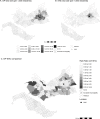The roles of the general practitioner and sexual health centre in HIV testing: comparative insights and impact on HIV incidence rates in the Rotterdam area, the Netherlands - a cross-sectional population-based study
- PMID: 38129840
- PMCID: PMC10734097
- DOI: 10.1186/s12889-023-17483-w
The roles of the general practitioner and sexual health centre in HIV testing: comparative insights and impact on HIV incidence rates in the Rotterdam area, the Netherlands - a cross-sectional population-based study
Abstract
Background: Access to HIV testing is crucial for detection, linkage to treatment, and prevention. In less urbanised areas, reliance on general practitioners (GPs) for HIV testing is probable, as sexual health centres (SHC) are mostly located within urbanised areas. Limited insight into individuals undergoing HIV testing stems from sparse standard registration of demographics at GPs. This cross-sectional study aims (1) to assess and compare HIV testing at the GP and SHC, and (2) to assess population- and provider-specific HIV incidence.
Methods: Individual HIV testing data of GPs and SHC were linked to population register data (aged ≥ 15 years, Rotterdam area, 2015-2019). We reported the proportion HIV tested, and compared GP and SHC testing rates with negative binomial generalised additive models. Data on new HIV diagnoses (2015-2019) from the Dutch HIV Monitoring Foundation relative to the population were used to assess HIV incidence.
Results: The overall proportion HIV tested was 1.14% for all residents, ranging from 0.41% for ≥ 40-year-olds to 4.70% for Antilleans. The GP testing rate was generally higher than the SHC testing rate with an overall rate ratio (RR) of 1.61 (95% CI: 1.56-1.65), but not for 15-24-year-olds (RR: 0.81, 95% CI: 0.74-0.88). Large differences in HIV testing rate (1.36 to 39.47 per 1,000 residents) and GP-SHC ratio (RR: 0.23 to 7.24) by geographical area were observed. The GPs' contribution in HIV testing was greater for GP in areas further away from the SHC. In general, population groups that are relatively often tested are also the groups with most diagnoses and highest incidence (e.g., men who have sex with men, non-western). The overall incidence was 10.55 per 100,000 residents, varying from 3.09 for heterosexual men/women to 24.04 for 25-29-year-olds.
Conclusions: GPs have a pivotal role in HIV testing in less urbanised areas further away from the SHC, and among some population groups. A relatively high incidence often follows relatively high testing rates. Opportunities to improve HIV testing have been found for migrants, lower-educated individuals, in areas less urbanised areas and further away from GP/SHC. Strategies include additional targeted testing, via for example SHC branch locations and outreach activities.
Keywords: Diagnoses; Epidemiology; General practitioner; HIV; Primary care; Sexual health centre; Testing.
© 2023. The Author(s).
Conflict of interest statement
The authors declare that they have no competing interests. The ATHENA database is maintained by stichting hiv monitoring (SHM) and supported by a grant from the Dutch Ministry of Health, Welfare and Sport through the Centre for Infectious Disease Control of the National Institute for Public Health and the Environment.
Figures
References
-
- Gilbert M, Thomson K, Salway T, Haag D, Grennan T, Fairley CK, et al. Differences in experiences of barriers to STI testing between clients of the internet-based diagnostic testing service GetCheckedOnline.com and an STI clinic in Vancouver, Canada. Sex Transm Infect. 2019;95(2):151–6. doi: 10.1136/sextrans-2017-053325. - DOI - PMC - PubMed
-
- Amiri S, Pham CD, Amram O, Alcover KC, Oluwoye O, Bravo L, et al. Proximity to Screening Site, Rurality, and Neighborhood disadvantage: treatment status among individuals with sexually transmitted Infections in Yakima County, Washington. Int J Environ Res Public Health. 2020;17(8). 10.3390/ijerph17082679. - PMC - PubMed
-
- McKenney J, Sullivan PS, Bowles KE, Oraka E, Sanchez TH, DiNenno E. HIV Risk behaviors and Utilization of Prevention Services, Urban and Rural men who have sex with men in the United States: results from a National Online Survey. AIDS Behav. 2018;22(7):2127–36. doi: 10.1007/s10461-017-1912-5. - DOI - PubMed
Publication types
MeSH terms
LinkOut - more resources
Full Text Sources
Medical
Miscellaneous


